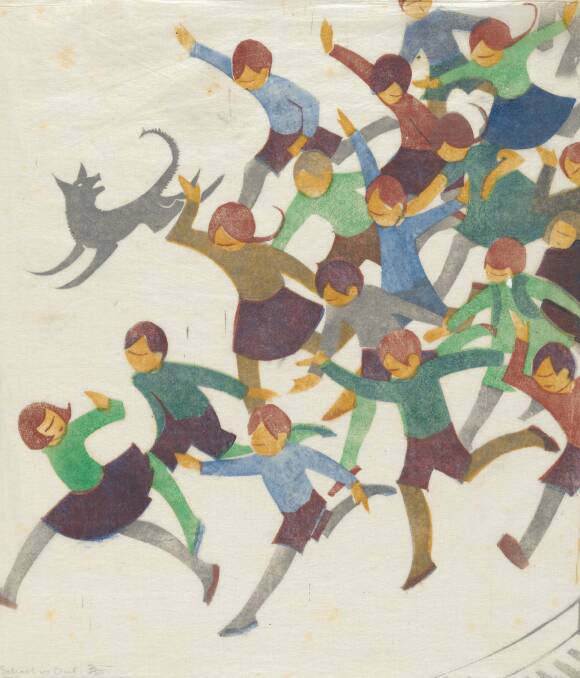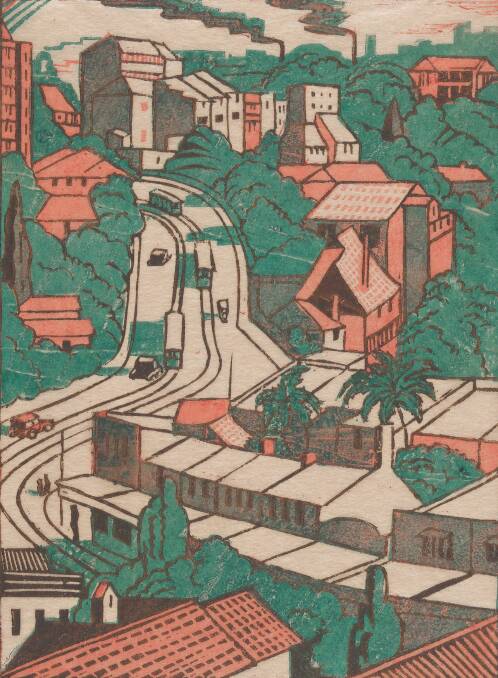
Ethel Spowers and Eveline Syme. Spowers and Syme. Canberra Museum and Gallery, corner of London Circuit and City Square, Civic. Until November 6, 2021. Monday to Saturday, 10am-5pm (Covid restrictions permitting). cmag.com.au.
Subscribe now for unlimited access.
or signup to continue reading
Ethel Spowers and Eveline Syme came from the Melbourne establishment. The daughters of two major newspaper magnates (The Argus and The Age), they were lifelong friends and both were prominent printmakers who championed a version of modernism.
Their most productive years fell in the period between the two World Wars when their art found a small band of champions and a couple of detractors. However, most of the art world simply ignored them until they were "rediscovered" posthumously in the 1980s as part of the revival of interest in the so-called Claude Flight School of modernist linocut printmakers.
This revival was spearheaded by the curator Stephen Coppel, firstly in Canberra and later in London. Today their prints are highly prized and command considerable prices on the art market.

This could be described as a perfect exhibition. It is small enough to be manageable, yet sufficiently comprehensive to give an excellent understanding of the two artists seen within their cultural context.
It is meticulously researched by Sarina Noordhuis-Fairfax, the curator of Australian prints and drawings at the National Gallery of Australia. She is also the author of the accompanying monographic catalogue, where the interwoven lives of the two artists are explored in her text, employing the metaphor of skating on ice.
The English artist Claude Flight, through the Grosvenor School of Modern Art in London, championed the colour linocut in Britain, with a whole army of talented pupils including the Australians Dorrit Black, Spowers and Syme.
There were a few peculiarities of Flight's method. One was his worship of the Italian Futurists - the exhilaration of speed and the demonic energy of machines. Flight translated this into curved dynamic lines and fragmented colours designed to express speed, movement and hustle of modern life.
Flight and his disciples used three or four blocks to print colour to produce an animated surface. The third feature of the Flight method was printing on very thin Oriental tissue paper, printing on the reverse side of the paper and allowing the image to bleed through to the other side, permitting a degree of subtlety.
The colour linocuts of Spowers and Syme have a glowing luminosity and rhythmic dynamism. Spowers's The works, Yallourn (1933), a print of considerable complexity and employing seven blocks, and Syme's Sydney tram line (1936) from three blocks, are outstanding examples of the Flight method. All is caught up within a dynamic explosion of energy with a rich and vibrant colour palette.
The beauty of this exhibition, at least in part, lies in the forensic matching up of sources and contexts. For example, a porcelain squirrel with an acorn appears in a Spowers print Still life (1932) with its dynamic play with shadows and in the exhibition the actual figurine is exhibited next to the print. In another instance, Spowers's joyful School is out (1936) print is matched up with the artist's drawing that served as the basis for the print.
When you recall that much of the work was made during the Great Depression, it is a gay and somewhat frivolous world that we encounter in their art. The artists did possess a social conscience and were heavily involved in charitable work, however in their art they celebrated a joyful innocence and hedonism.
Spowers and Syme may not have made work of the same calibre as Jessie Traill and Dorrit Black, however, they did produce a body of exquisite prints that have finally been recognised and are celebrated in this wonderful exhibition.

